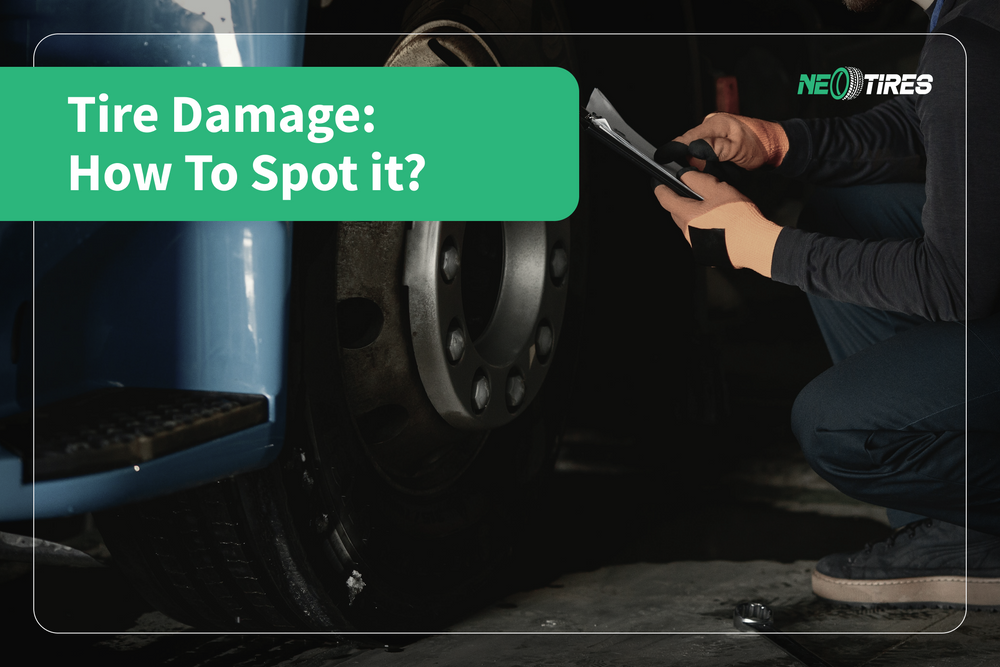Just as you are used to visiting the physician for a regular health checkup, this is how you should check the "health" of your car's tires. It is wrong to think that they do not need attention. And believe us, you can prevent many tire issues if you regularly inspect them for signs of damage and wear.
The explanation is simple: tires are exposed to a huge effort, stress, and challenge every day. How do you want them to last over time without being somehow affected? They must cope with the car body load, as well as different road and weather conditions. At the same time, they must optimize the performance of the vehicle and be responsive to steering, cornering, and breaking. In addition, take into account the fact that all these stressful stimuli fall only on a small portion of the tire, and not on its entire surface.
Why Should You Inspect Your Tires?
Tires become abrasive and worn over time. These are the most exposed components of the car to permanent and direct impact with the road. Even if their construction is designed to withstand the damage caused by the road, they get worn over time anyway. Ignoring the signs of wear and tear has drastic consequences; I don't think it's necessary to list them, because you realize what can happen. Apart from the risk to traffic safety, you also risk remaining without a driving license, because wearing severely damaged tires is actually illegal.
How do you detect signs of wear and damage on your tires? How often should you inspect them? Are there any means to prevent or minimize potential damage to them? Let's see together how we can contribute to reducing all the risks coming from tire damage.
Tire Sidewall And Tread
Everything is more than simple. You only need the desire and interest in maintaining the good condition of your tires. In this sense, all that you have to do is visually inspect the condition of the tire sidewalls and treads from time to time. In an ideal scenario, check your tires every week. You never know how an intruder, such as a nail, might infiltrate your tire. Draw attention to the condition of the tire along the entire circumference to identify any flaws.
Signs that suggest something is wrong with your tires are abnormally widened grooves or irregular spaces between the tire blocks.
At the same time, you should draw attention to the tire cracks, if any. Minor cracks are an indication that they will become major soon because they are irreversible from the moment they appear. So, you can start thinking about a tire change.
Also, pay attention to other potential intruders, as I like to call them. These refer to all kinds of foreign objects such as stones with sharp edges, nails, or tacks that lead directly to a tire puncture with subsequent tire pressure loss. Gradual reduction of pressure leads to a flat tire, while the sudden loss of pressure can expose you to a blowout risk, which is much more dangerous.
Tire Damage Warnings
Be careful when extracting the small pebbles from the tread channels. They may seem harmless, but they can cause you a small puncture that turns into a big one as soon as possible. To remove them, use a screwdriver blade and make sure that the surface of the tire is not severely damaged.
Draw attention to the homogeneity of the treads. Areas that are subject to aggressive braking become flatter, causing further uneven wear. Also, don't underestimate tire shoulders. These are very sensitive areas. If they show symptoms of uneven wear, do not postpone tire replacement. Tire shoulder uneven wear suggests possible interior damage. For this reason, it would be good to consider the internal inspection of the tire.
On the whole, a visual inspection of the outer tire is not enough. Specialists recommend that once in a while (once every 3-6 months) you remove the tire from the rim for an internal inspection.
If tire sidewalls show bulges on their surface, this speaks of possible carcass damage. Continuing to wear these tires can lead to risks when the car runs at high speed. If the technician confirms the carcass construction damage, you will have to replace the tires.
One last detail: don't wait until your tires are completely damaged. As a rule, they show visible signs on the outside, already after they have been severely affected inside. In these cases, regular inspection is a must to prevent major damage.
Why To Inspect The Tire Tread?
Yes, it tells us a lot. For this reason, you must inspect not only the general condition of the tire but also its depth. Each country has its own rules regarding admissible tire depth. Britain, for example, does not allow the use of tires with depths less than 1 mm. However, the specialists recommend not reaching the limit allowed by the regulatory bodies because this is a much too risky limit. It is not at all wise to drive a vehicle with severely worn-out tires. So, the deeper the tread pattern, the safer you are on the road.
In this context, I recommend you abstract from the rules of the state and add some tire thickness in the interest of safety. If the country you live in allows a depth of up to 1.5mm, set your own limit of 2mm. If the state requires a 1mm limit, assure yourself with a 1,5mm limit. The greater the depth, the greater the hope for safe driving.
Do New Tires Need Tread Depth Inspection?
... checking the tread depth regularly is not really necessary. But once you detect the first signs of wear off, or opt for second-hand tires, frequent checking of the tread depth is as important as checking the tire pressure.
You can take the measures by yourself. You will need either a penny or a screwdriver and a ruler. Use the screwdriver to insert it into the depth of the tread, then measure with a ruler how many millimeters it has entered. You can do the same with the coin.
Alternatively, you can buy a tool for measuring tread depths to always have one in your garage.
After all, you can turn to a technician. It takes no more than a minute to measure your tread depth. So you have a multitude of measurement options. Accordingly, there is no reason to skip the periodical check of your treads' depth. This is a mandatory measure that lets you understand that driving with bald tires is becoming riskier for your safety with every ride.
Bottom Line
The performance of your vehicle is directly proportional to the condition of your tires. And more than that, they directly influence the stability of the vehicle on the road and your safety in it. For this reason, I think it is important to exclude all potential factors that can influence the condition of the vehicle's tires. One of the simplest methods is to inspect them regularly.
It is not necessary to be an expert technician to differentiate between a damaged tire and a good-condition one. You just need the will and a little time. After all, you can call on a specialist from the technical center to give you a general assessment.
What you have to remember is that inspecting the tires from the outside is not enough. Try to find out what is inside it. At the same time, the health of your tires must be your number one priority as a driver. With that in mind, a tire checkup must be the order of the day for you.
Tire Signs Of Wear: FAQs
How Do You Tell if Your Tires Are Wearing?
The best thing you can do for the "health" of your tires is to inspect them regularly. With regular inspection, you will be able to detect the first signs of wear and take the necessary measures to avoid further damage. Draw attention if there are sidewall cuts and cracks. Pay attention to tire wear. If you detect portions where uneven wear is present, it would be good to rotate your tires. Check the tire tread depth. The simplest way is the Penny test. If you notice that the handling of the vehicle becomes poorer, vibrations appear while driving, tires just stop gripping, or the overall tire performance decreases, this might suggest that your tires are wearing.
What Are Wear Indicators on Tires?
Tire makers integrate small markings into the tire tread to inform you about their irregular wear. These marks become more and more obvious with the gradual wear of the tread. If you find them during the inspection, this means that your tire is about to reach the 2/32'' limit, which is not at all safe for further driving. In that case, it's time to think about a new set of tires.
Why is a Tire Inspection Important?
Regular inspection of the tires will help you detect potential damage in the early stages. This will allow you to take measures to reduce the damage and extend the serviceability of the tires. If it is difficult for you to assess the condition of the tires, a mechanic could easily help you. He will draw attention to the condition of the sidewalls, uneven wear, tire tread depth, and their overall "health". Ignoring tire inspection might lead to severe tire damage with subsequent safety risks while driving.
How Often Should You Inspect Your Tires?
The more often the better. Well, I realize that it is somewhat uncomfortable to inspect the tires every morning. But at least once a month is the minimum you can do. I recommend doing inspections in daylight when you can clearly see the condition of the tire from different angles. I personally inspect them including before and after every weekend long trips, which I also recommend to you.
Why Trust Us?
While we cannot convince you that we are truly a reliable tire dealer, we can certainly tell you what we are proud of. We are proud of a young team of enthusiasts and madly passionate about tires and driving experiences. Each member of the team brings his contribution through deep knowledge accumulated through experience in this field. Here we love to test and evaluate tires from various perspectives, after which we write unbiased and objective reviews so that our customers know what they can expect from the products they choose.
Each of us passionately follows the news and advancement of the tire industry. This is because we want to contribute to improving the driving experience of every customer who calls us. Last but not least, we collaborate with various tire makers to offer the best tire deals as we know how important the price/quality balance is for every driver. As such, we do our job as best we can and we are happy to assist any driver with any question. Contact us. Our experience is enough to offer you high-quality service and products. Drive safely and take care of your tires!





